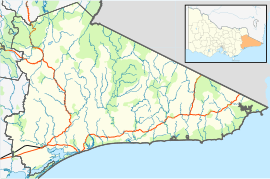Lake Tyers Mission facts for kids
Quick facts for kids Lake Tyers MissionVictoria |
|||||||||
|---|---|---|---|---|---|---|---|---|---|
| Postcode(s) | 3909 | ||||||||
| Location |
|
||||||||
| LGA(s) | Shire of East Gippsland | ||||||||
| State electorate(s) | Gippsland East | ||||||||
| Federal Division(s) | Gippsland | ||||||||
|
|||||||||
Lake Tyers Mission, also known as Bung Yarnda, was a special place for Aboriginal people in Victoria, Australia. It was set up in 1863 by a Christian missionary. The mission was located on the shores of Lake Tyers in the Gippsland region. It was meant to be a central home for Aboriginal people from all over Victoria.
Contents
History of Lake Tyers Mission
The Lake Tyers Mission Station was started by Reverend John Bulmer in 1863. He was a missionary from the Church of England. This happened after many years of trouble between the Kurnai people and new settlers in Gippsland.
Reverend Bulmer first tried to start a mission near Buchan in 1861. But he later moved south to the coast. He went with the few Aboriginal people who had survived the conflicts. The place he chose was on a peninsula, with a lake on each side. The traditional owners knew this area as Bung Yarnda.
Relocation of Aboriginal Communities
In the early 1900s, Aboriginal people from other missions in Victoria were moved to Lake Tyers. These missions included Ramahyuck, Lake Condah, and Coranderrk. For example, the Ramahyuck Mission closed in 1908. The Ganai people from west and central Gippsland were then moved to Lake Tyers.
The Ebenezer Mission also closed in 1904 because there were not many people left. Over the next 20 years, many Wergaia people from north-western Victoria were also forced to move to Lake Tyers. The Victorian Government took control of Lake Tyers in 1908.
Government Control and Assimilation
In 1916, the Government of Victoria decided to bring all Aboriginal people from across Victoria to Lake Tyers. The Aboriginal Protection Board made a rule in 1917 to gather all Aboriginal people at the Lake Tyers reserve.
In 1957, the Board for the Protection of Aborigines was ended. In the 1960s, the Victorian Government tried to close the settlement. Their goal was to make the residents live like other people in the general community. This idea was called "assimilation." Some people were moved to different parts of the state. These new places were not always their traditional lands.
Protests and Land Rights
During the 1950s and 1960s, people at Lake Tyers wanted to run their own farming business. They wanted it to be an independent, Aboriginal-run cooperative. The Aborigines Advancement League in Melbourne supported them.
Pastor Sir Doug Nicholls helped them by speaking up for their rights. But when the Board tried to close Lake Tyers, Nicholls quit his job to protest. However, in 1965, the mission was officially made a Permanent Reserve. This meant it could not be easily closed.
In 1970, the Aboriginal Lands Act 1970 was passed. This was a very important law in Victoria. It was the first law to officially recognise land rights for Aboriginal people. This law gave ownership of Framlingham in western Victoria to an Aboriginal trust in 1971. Lake Tyers and Framlingham were the last reserves to close in Victoria.
In 1971, the remaining residents of Lake Tyers were given full ownership of about 237 hectares (2.37 square kilometers) of land. This became a self-governing community under the Lake Tyers Aboriginal Trust. Each adult and child received a share in the land.
The Aborigines Advancement League had worried about losing Aboriginal land back in 1948. They told the government that "land titles of Lake Tyers must be transferred with due precaution." This was to stop anyone from trying to take the land from the Aboriginal people. Laurie Moffatt, a spokesman for Lake Tyers residents, explained their feelings. He said they did not want Lake Tyers to be sold to white people, like other missions had been.
Administration of the Trust
In 2003, the government appointed an administrator named Simon Wallace-Smith to manage the trust. However, the people who owned shares in the trust did not agree with this. In 2011, they blocked the entrance to the site for two weeks. They camped at the gate and did not let government officials enter. Police had to escort Wallace-Smith back in.
Notable Residents of Lake Tyers
Albert Mullett
Albert Mullett was born in Melbourne in 1933. He lived with his family near Lake Tyers. When families who were considered "part-Aboriginal" were forced to leave the mission, his family moved to the other side of the lake.
John Gorrie
John Gorrie PSM was born in Melbourne on March 10, 1950. He lived at Lake Tyers from about 1952 to 1960. He is a descendant of Charlie Hammond, who survived the Brodribb River massacre. John Gorrie was the first Aboriginal man to receive the Public Service Medal in 2005.


